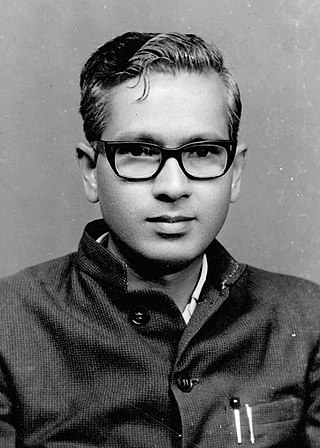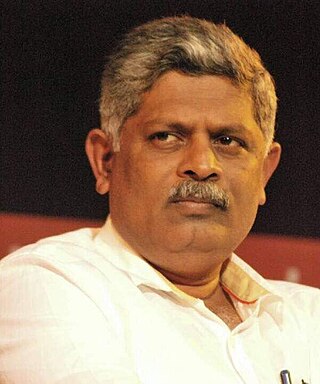
Kannada literature is the corpus of written forms of the Kannada language, spoken mainly in the Indian state of Karnataka and written in the Kannada script.

Kuppalli Venkatappa Puttappa, popularly known by his pen name Kuvempu, was an Indian poet, playwright, novelist and critic. He is widely regarded as the greatest Kannada poet of the 20th century. He was the first Kannada writer to receive the Jnanpith Award.

Kannada Saahithya Parishath is an Indian non-profit organisation that promotes the Kannada language and its literature. Its headquarters are in the city of Bengaluru in the state of Karnataka, India. It strives to promote Kannada language through publishing books, organising literary seminars and promoting research projects. It also organises an annual conference on Kannada literature called Kannada Sahithya Sammelana. The current president of the parishat is Dr. Mahesh joshi.

Purohita Thirunarayanaiyengar Narasimhachar, commonly known as PuTiNa, was a playwright and poet in the Kannada language. Along with, Kuvempu and D. R. Bendre, he forms the well-known trio of Kannada Navodaya poets. He was awarded the Padma Shri by the Government of India in 1991. He was a Sahitya Akademi fellow and the winner of the Pampa Award, awarded by the Government of Karnataka in 1991.

Pampa, called by the honorific Ādikavi was a Kannada-language Jain poet whose works reflected his philosophical beliefs. He was a court poet of Vemulavada Chalukya king Arikesari II, who was a feudatory of the Rashtrakuta Emperor Krishna III. Pampa is best known for his epics Vikramārjuna Vijaya or Pampa Bharata, and the Ādi purāṇa, both written in the champu style around c. 939. These works served as the model for all future champu works in Kannada.

Kuppali Puttappa Poornachandra Tejaswi was a prominent Indian writer and novelist in Kannada. He also worked as a photographer, publisher, painter, naturalist, and environmentalist. He made a great impression in the Navya ("new") period of Kannada literature and inaugurated the Bandaaya Saahitya genre of protest literature with his short-story collection Abachoorina Post Offisu. He is the son of noted Kannada poet Kuvempu.

Karnataka, a state in South India has a long association with Jainism, a religion which enjoyed patronage of major historic kingdoms in the state such as the Rastrakuta Dynasty, Western Ganga, Kadamba and Chalukya dynasties and the Hoysala Empire. Today the state is home to a number of Jain monuments, such as temples, Gommata statues and stambhas.

Guggari Shanthaveerappa Shivarudrappa, or colloquially GSS, was an Indian Kannada poet, writer, and researcher who was awarded the title of Rashtrakavi by the Government of Karnataka in 2006.
M. Chidananda Murthy was a Kannada writer, researcher and historian. He was a well-known scholar in Karnataka specializing in the history of Kannada language and ancient Karnataka. He was also known for his campaign to conserve the monuments Hampi and to secure classical language status to Kannada Language. Murthy also articulated that uniform civil code and an anti-conversion law must be enacted by the Government in India.
The Pampa Award is a literary award in the Indian state of Karnataka. The award was established in 1987 by the government of Karnataka. It is the highest literary honor conferred by the Department of Kannada and Culture, Government of Karnataka State, and recognises works written in the Kannada language.

Devegowda Javaregowda, known as De Ja Gou or simply Javaregowda, was an Indian Kannada writer, folklorist, researcher, scholar and academic. He was disciple of authors T.N. Srikantaiah and Kuvempu. His literary career spans over decades in which he wrote over thirty-four biographies in Kannada language and other works including children's literature. He campaigned for the promotion of Kannada language. He had received Pampa Prashasti (1998), Padma Shri (2001) and the Karnataka Ratna (2008) awards for his contributions in literature and education. He became a centenarian in 2015 and died on 30 May 2016.

Togere Venkatasubbasastry Venkatachala Sastry, commonly known as T. V. Venkatachala Shastry, is a Kannada-language writer, grammarian, critic, editor and lexicographer. He has authored in excess of 100 books, translations and has edited collections of essays, biographical sketches and felicitation volumes. Recipient of the Kannada Sahitya Akademi Award (honorary), Sastry is an authority on Kannada language grammar and its various facets ranging from the metre scale on which he has written extensively to the history of Kannada literature spanning two millennia.

Kuppur Yalappa Narayanaswamy, also known as KYN, is a popular Kannada poet, scholar, critic, and playwright. He is currently a Kannada professor in the Maharani Cluster University, Bangalore. He is the author of many popular Kannada plays including Kalavu, Anabhigna Shakuntala, Chakraratna, Huliseere, and Vinura Vema. He has also translated Kuvempu's Shudra Tapaswi into Telugu. He is credited with adapting Kuvempu's magnum opus Malegalalli madumagalu into a 9-hour play. He has also written the screenplay for the films Kalavu and Suryakaanti.

Sondekoppa Srikanta Sastri was an Indian historian, Indologist, and polyglot. He authored around 12 books, over two hundred articles, several monographs and book reviews over four decades in English, Kannada, Telugu and Sanskrit. These include "Sources of Karnataka History", "Geopolitics of India & Greater India", "Bharatiya Samskruthi" and "Hoysala Vastushilpa". S. Srikanta Sastri was a polyglot well versed in fourteen languages spanning Greek, Latin, Pali, Prakrit, Sanskrit and German among others. He was Head of the Department of History & Indology at Maharaja College, University of Mysore between 1940 and 1960. He was conferred the Kannada Literary Academy award in 1970 and was subsequently honoured by Governor of Karnataka Mohanlal Sukhadia in 1973 during mythic society diamond jubilee function. A Festschrift was brought forth and presented to him during his felicitation function in 1973 titled "Srikanthika" with articles on History and Indology by distinguished scholars. His work on Indus Valley civilization and town planning at Harappa and Mohenjodaro were published in successive articles and drew considerable attention. His articles on The Aryan Invasion theory, the date of Adi Sankaracharya, Oswald Spengler's view on Indian culture, Jaina epistemology, Proto-Vedic religion of Indus Valley Civilization and evolution of the Gandabherunda insignia remain relevant today.
Nagachandra or Abhinava Pampa was a 12th-century poet in the Kannada language.
Hampasandra is a village in the southern state of Karnataka, India. It is located in the Gauribidanur taluk of Chikkaballapura district in Karnataka. It is situated 15 km (9.3 mi) away from sub-district headquarter Gauribidanur and 60 km away from district headquarter Chikkaballapura.

Kamala Hampana was an Indian writer who wrote in the Kannada language. Born in Devanahalli in Karnataka, she worked as a scholar and professor of ancient works and undertook studies on different genres of Kannada literature, as well as topics involving Jainism.

Haleyuru Srinivasa Krishnaswamy Iyengar was a Kannada columnist, essayist, novelist, critic and teacher of Economics and Commerce studies in Mysore. He is remembered for his character sketches and short essays on personalities and issues of national & international import, in his weekly column "Varada Vyakthi". These appeared in the Kannada magazine "Sudha" continuously for nearly two decades. His literary critique "Kannadadalli Vidambana Sahitya" won him the Kannada Sahitya Akademi Award in 1981. His perspective on elements of Vishistadvaita in the works of Kuvempu were brought forth in his book "Kuvempu Sahityadalli Vishistadvaita – Darshana". H. S. K. penned close to thousand character sketches over two decades. These were later published in four collected volumes. He received the "Rajyotsava Award" from Government of Karnataka in 1997. For his lifetime contribution to Journalism and Kannada literature, the University of Mysore conferred a doctorate degree on him in 2004.

B.S Sannaiah was an Indian writer in Kannada language. He was born in Bhoganahalli, Piriyapatna talluk, Mysore, Karnataka. He worked as a Editor, Textual critic and a follower and protector of ancient Archaic works & manuscripts. He had undertaken study and research in various manuscript works in Kannada & jain literature and made some of the major contributions in the field.

Taľaku Subbanna Venkannayya was University of Mysore's first Kannada Professor. He was also a popular Kannada writer, translator, editor and teacher who nurtured many later Kannada littérateurs like Kuvempu, D. L. Narasimhachar, T. N. Srikantaiah, K. S. Narasimhaswamy, M. V. Seetharamaiah, C. K. Venkataramaiah, K. Venkataramappa, G. Venkatasubbiah and S. V. Parameshwara Bhatta. In fact, Kuvempu begins his book Sri Ramayana Darshanam with a two-page dedication to his teacher T. S. Venkannayya. T. S. Venkannayya translated the biography of Ramakrishna Paramahamsa from Bengali into Kannada for the first time in 1919. T. S. Venkannayya along with D. V. Gundappa, V. Seetharamaiah, B. M. Srikantaiah and T. N. Srikantaiah were at the forefront of the Kannada Movement from 1920s onwards and were instrumental in the founding of Kannada Sahitya Parishat (Bangalore) and Kannada Sangha at Central College, Bangalore and Maharaja College, Mysore. T. S. Venkannayya was responsible for the organising of the 1931 Kannada Sahitya Sammelan at Mysore.
















